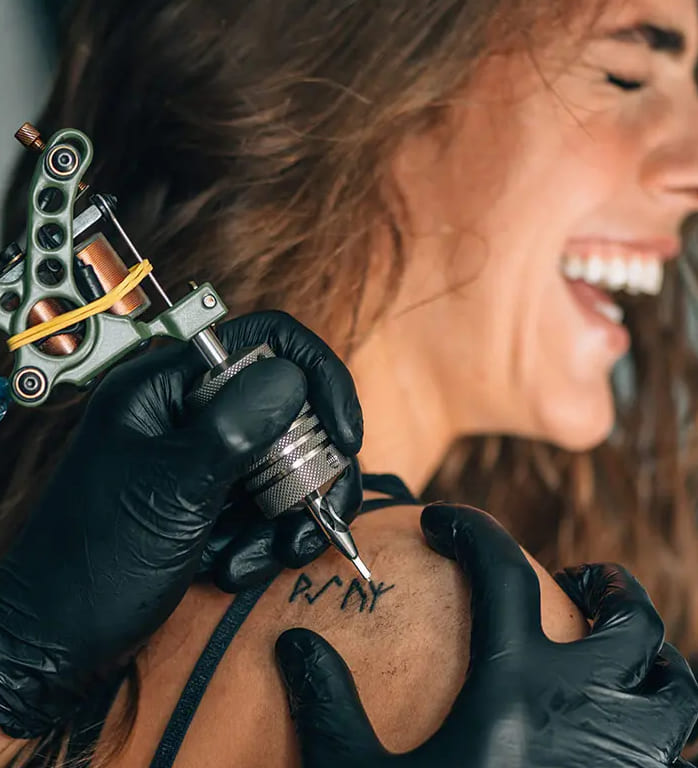
BOOK YOUR APPOINTMENT NOW!
- Shop 62, Brisa Residency Complex, Naika vaddo, Bardez, Calangute Candolim Sinquerim Rd, Calangute, Goa - 403516
- info@sandytattoo.com
- +91 95526 66999
How painful are tattoos, particularly in sensitive areas like the wrist, and what level of discomfort should one expect

Introduction to Tattoos and Pain Levels
Are tattoos painful? It's a question that many people ask before taking the plunge and getting inked. The truth is, pain levels can vary depending on several factors, including the location of the tattoo. In particular, sensitive areas like the wrist can be more prone to discomfort during a tattoo session. But fear not! In this blog post, we'll explore just how painful tattoos can be and provide some tips for minimizing discomfort along the way. So if you're considering getting a tattoo or simply curious about what to expect, keep reading!
Factors that Affect the Level of Pain During a Tattoo Session
Factors that affect the level of pain during a tattoo session can vary from person to person. One factor is the location of the tattoo on the body. Sensitive areas like the wrist, inner arm, and ribcage tend to be more painful than less sensitive areas like the outer bicep or thigh.
Another factor is individual pain tolerance. Some people naturally have a higher threshold for pain and may find tattoos less uncomfortable overall. On the other hand, individuals with lower pain thresholds may experience more discomfort during a tattoo session.
The size and complexity of the design also play a role in determining how painful a tattoo will be. Larger tattoos that require multiple sessions can cause more prolonged discomfort compared to smaller, simpler designs that can be completed in one sitting.
Additionally, different techniques used by tattoo artists can influence pain levels. Traditional methods involving manual tools may result in more intense sensations compared to modern machines that are designed for smoother application.
Proper aftercare plays an important role in reducing discomfort and promoting healing post-tattooing. Following instructions provided by your artist such as keeping it clean, applying ointment regularly, and avoiding direct sunlight helps minimize any potential soreness or irritation.
Tips for Minimizing Pain During a Tattoo Session
When it comes to getting a tattoo, pain is often one of the biggest concerns. While everyone's pain tolerance varies, there are a few tips you can follow to help minimize discomfort during your tattoo session.
- Choose the right placement for your tattoo. Sensitive areas like the wrist may be more painful than other parts of the body. If you're worried about pain, consider opting for a less sensitive area such as the upper arm or thigh.
- Communicate with your tattoo artist throughout the process. Let them know if you need breaks or if you're experiencing excessive discomfort. They can adjust their technique and pace accordingly to make it more bearable for you.
- Stay hydrated before and during your tattoo session. Dehydration can increase sensitivity to pain, so drink plenty of water beforehand.
- Use distraction techniques such as listening to music or doing deep breathing exercises to take your mind off any discomfort.
- Follow proper aftercare instructions provided by your tattoo artist to minimize post-tattoo discomfort and promote healing.
Aftercare Tips for Reducing Discomfort and Promoting Healing
Taking proper care of your new tattoo is essential not only for its longevity but also for minimizing any lingering discomfort. Here are some aftercare tips to help you reduce pain and promote healing:
- Follow the instructions provided by your tattoo artist: Your tattoo artist will provide you with specific aftercare instructions tailored to your tattoo. It's crucial to follow these guidelines diligently, as they know best how to care for their artwork.
- Keep it clean: Gently wash your tattooed area with mild soap and lukewarm water two to three times a day. Pat dry using a clean towel or air-dry naturally, avoiding harsh rubbing or scrubbing.
- Apply appropriate ointment: After cleaning, apply a thin layer of recommended ointment or moisturizer suggested by your artist or dermatologist. This will keep the skin hydrated without suffocating the fresh ink.
- Avoid excessive moisture exposure: While it's important to keep your tattoo moisturized, avoid soaking it in pools, hot tubs, baths, or saunas during the initial healing period (usually 2-3 weeks). Prolonged exposure to water can disrupt the healing process and increase discomfort.
- Protect from direct sunlight: UV rays can fade tattoos and cause irritation during the healing phase. Make sure to shield your freshly inked skin from direct sunlight by wearing loose clothing or applying sunscreen (SPF 30+) once it has fully healed.
- Avoid picking at scabs: As part of the natural healing process, scabs may form over your tattooed area within a few days after getting inked. Refrain from picking at them as this could lead to infections and prolong discomfort.
- Stay away from tight clothing: Opt for loose-fitting clothes that won't rub against or irritate your new tattoo while it heals – especially if it's on a sensitive area like the wrist. This will help minimize any potential pain or discomfort.
is proudly powered by WordPress
